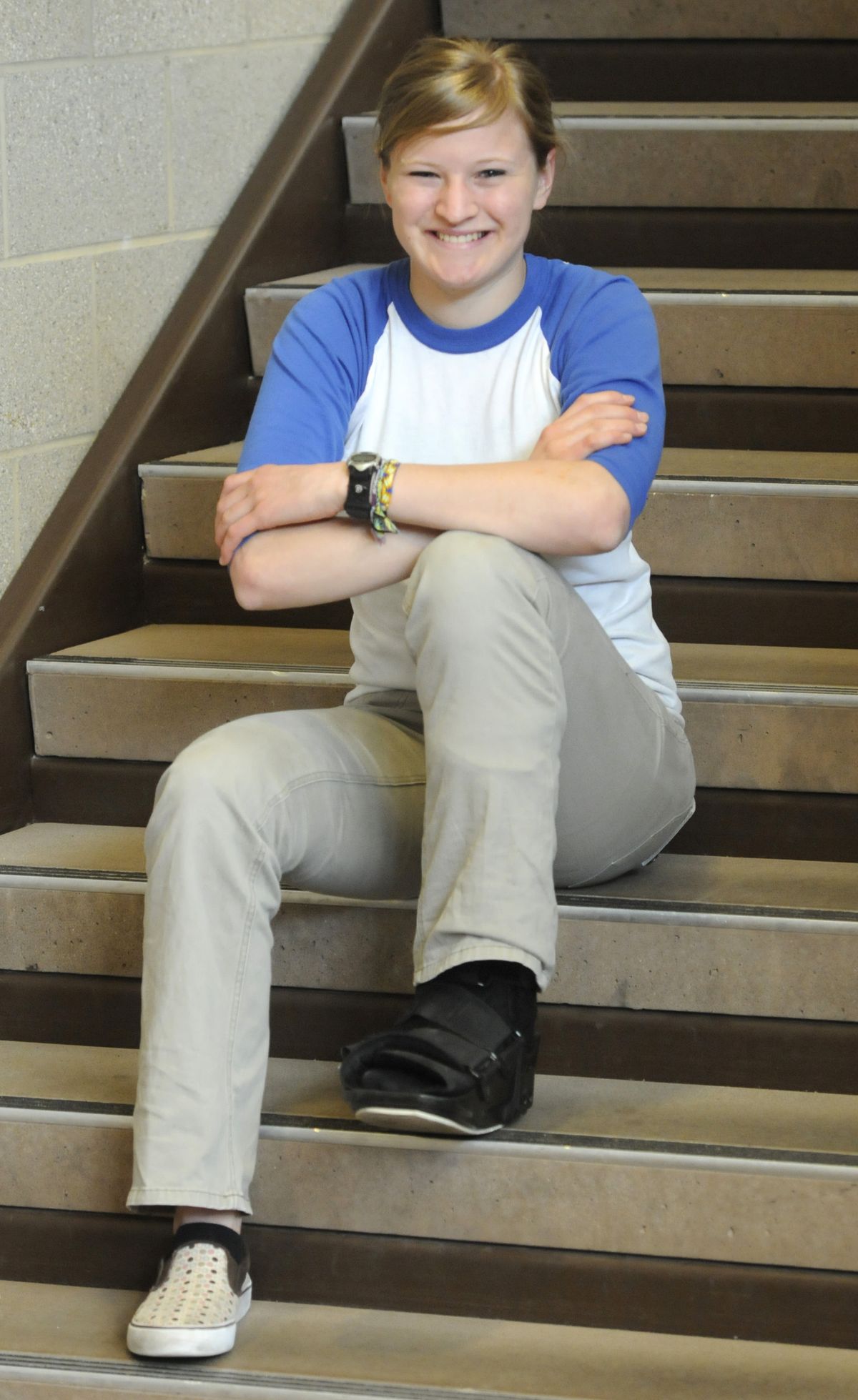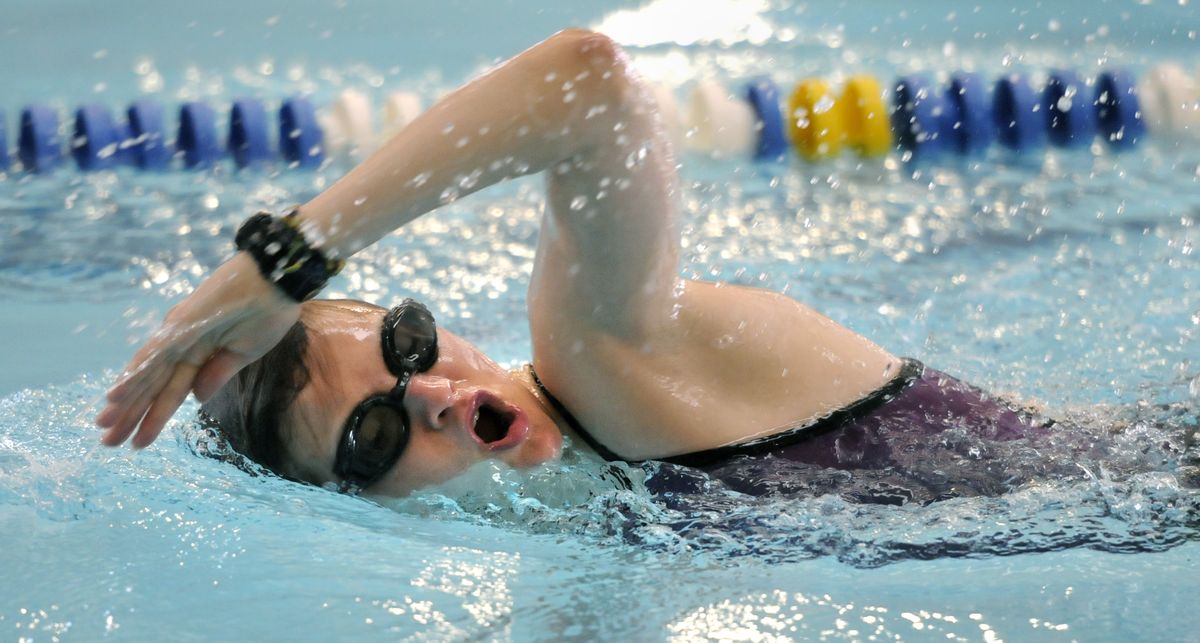Tough going the distance
Natural growth spurts challenge female runners such as Shadle’s Andrea Nelson
Senior Andrea Nelson works out in the YMCA pool in north Spokane to keep in shape while her lower leg heals. (Dan Pelle)
In four years of high school, Andrea Nelson has gone from one of the most successful distance runners in Spokane to homecoming queen.
That is not a bad thing by any stretch of the imagination, but it isn’t necessarily as good as one might imagine.
Nelson was far from homecoming queen material when she entered Shadle Park as a 5-foot, 95-pound freshman. She was, however, a distance running phenom, finishing second at the State 4A cross country championships in the fall and third in the 3,200 meters and fifth in the 1,600 at the State 4A track meet in the spring.
Since then Nelson has grown more than 6 inches, adding the commensurate weight that goes with it.
“I knew it was coming,” she said, “but I told myself it wasn’t going to happen to me, not realizing it happens to everyone.”
As her body grew, so did her times. Although she continued to have success, she didn’t have the against-the-clock improvement that measures her sport. Last spring she medaled at the State 3A track meet in the 1,600 and 3,200 meters and in the fall was fourth in the State 3A cross country meet – but her times were slower than in past years when she medaled in State 4A competitions.
“Before I could go off just pure talent, now I have to train much harder, get in miles I never had to worry about when I was young,” Nelson said. “It’s definitely harder to tell myself I can be as fast as I was when I was younger. I know the talent is there, but you have to work a little harder.”
Nelson believes the extra miles contributed to a shin problem that has sidelined her for the start of this season. Her goal is to break the school record in the 3,200 but she isn’t sure when, or even if, she’ll get back on the track.
“It’s just something that hangs over coaches of females,” Highlanders coach Bob Isitt said. “They grow up. It takes an adjustment, mentally, physically and emotionally to try to overcome this.”
“We’re just now as a family getting our arms around it,” father Doug Nelson said. “You would think with daughter No. 4 we would have broken the code by now.”
He was only half kidding because the same thing happened to Cami, the Nelsons’ fifth child and third daughter. Cami, who graduated in 2006, was the Highlanders’ No. 1 cross country runner for four years, despite having to work through the same issues.
“Every girl doesn’t go through growth spurts in high school,” mother Edie Nelson said. “Our girls developed late. I remember thinking with Andrea maybe it will be different.
“The struggle is their brain is saying one thing and their body is saying another. (But) they’re women. They have other functions.”
Although Nelson won 4A cross country as a sophomore and 3A as a junior, she wasn’t as fast as that first year and last fall was 21 seconds slower even though she was fourth in 3A. Isitt said she appeared to be getting close to her previous times but was sick at state.
“Andrea was so good we thought she was going to run right through womanhood,” said Doug Nelson, who added that his other daughters were more sprinters than distance runners. “She didn’t.”
The early bloomers are the ones, if athletic, who might turn to basketball or volleyball because their size and strength is an advantage.
Nelson recalls girls she outran in elementary school getting bigger and stronger and leaving her in the dust in junior high, only to pass them by in high school.
“I used to play basketball, I used to play soccer,” said Baylee Mires, a junior at Mead and a rival and friend to Nelson. “It sucks being little. In basketball I was always the shrimp and that’s not fun.”
She turned to running and has been as successful as Nelson. She won the State 4A 800 and 1,600 titles and anchored the Panthers’ winning 1,600 relay team.
“Baylee still has that little junior-high boy body,” said John Mires, who has the perspective of a father as well as being Mead’s boys track coach. “Once they get out of that frame, that slender, broad shoulder, little waist, they have a lot more obstacles.
“No doubt being that size helps her get around the track.”
“There’s always that fear, being a female runner, that you’re going to possibly become a woman,” Baylee, a wispy 5-6, 105 pounds, said.
That’s when things can get complicated.
“As the years go on, biology kicks in,” former North Central girls track coach Darren Nelson (no relation) said. “There are some questions a coach has a hard time answering. Girls, it doesn’t matter if they’re runners, are different as seniors than they were as freshmen. For some girls it’s harder to accept.”
Some try to diet back to their “successful” size while others try to push themselves harder to recapture the success.
“We talk about it,” Mead coach Dori Robertson said. “We talk about being patient. It takes a while to adjust to that different body. You work with it. You don’t want to change genetics, you don’t want to change who they’re supposed to be. I try to get them to be the healthiest person they’re supposed to be.”
Nutrition is a topic, along with smart training.
“You want to keep them from injury, because once you get in that cycle it’s tough to get out,” Robertson said.
The injury is frustrating to Nelson, though a scholarship to run at BYU helps.
“Without that, I would be really sad I can’t run right now,” she said. “I tell myself I’m not running now so I can continue to run.”
Not everyone has that luxury.
“There are girls who grow quite a bit and will not be competitive runners anymore,” Isitt said. “It’s just the nature of their body. They’re still wonderful kids, but I’ve had tears because they know it’s happening and there’s nothing they can do.”
Isitt encourages the girls to stick with the team, whether it is cross country or track, preferably both.
“I tell them they can still go out and enjoy running,” he said. “I tell them we need their spirit and enthusiasm on the team. If they come out of it before they graduate, great. If not it’s still going to be a positive experience.
“If it’s strictly competition, drop out. If it’s more than competition, if it’s the atmosphere, the experience, it’s worth it to stay.”
Most stay, he said.
Nelson said she loves to run but enjoys the companionship more, so she encourages others to stick it out.
“Have patience and remember why you started running in the first place, because you have a love and passion for something others don’t like doing,” she said. “Instead of being small and scrawny, you’re going to be big and strong. It’s just a trial and you can get through it.”
Her mother had a message as well.
“We want them to grow into who they are,” Edie Nelson said. “We’re not raising runners, we’re raising young ladies, individuals. These girls have talent. They run, but they do other things, too. And they can still run.”


